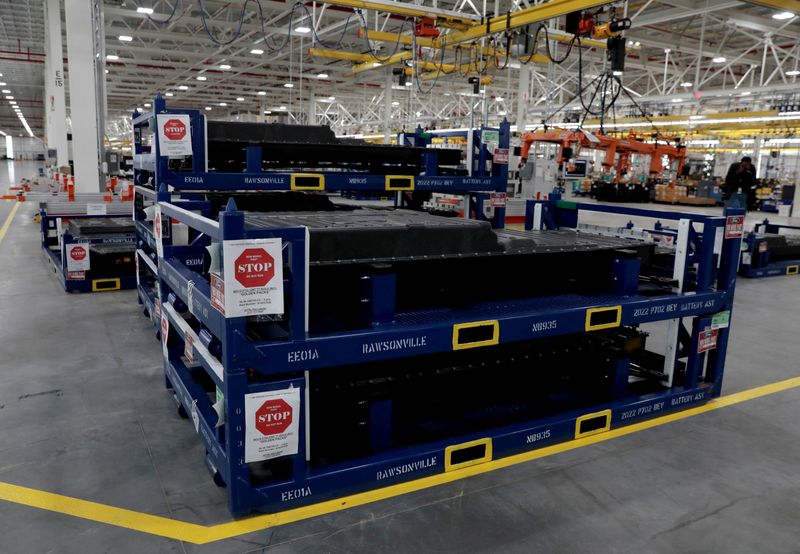By John Kemp
LONDON – U.S. manufacturing production probably peaked during the second quarter, though the data are noisy and conflicting, and a turning point may not become obvious until September or October.
U.S. manufacturing output in June was down by 0.4% compared with March though it was still up by 3.6% compared with the same month a year earlier, estimates prepared by the Federal Reserve Board found.
Three-month output growth was the weakest since early 2021, and confirms slackening momentum evident in other data on output, orders and jobs (“Industrial production and capacity utilisation”, Federal Reserve, July 15).
U.S. manufacturing employment increased by 30,000 in July and by 476,000 compared with the same month a year earlier, according to separate estimates prepared by the U.S. Bureau of Labor Statistics.
But the three-month rate of job creation has halved since April, another sign momentum is fading (“Current employment survey”, BLS, Aug. 5).
Manufacturers are almost evenly divided on whether business activity is expanding or contracting, based on survey data from the Institute for Supply Management (“Manufacturing report on business”, ISM, Aug. 1).
The ISM’s composite activity index slipped to 52.8 in July (50th percentile for all months since 1980) down from 57.1 in March (72nd percentile).
But the new orders component was just 48.0 in July (15th percentile) down from 53.8 in March (37th percentile) and 61.7 in February (84th percentile), implying that the sector will slow further in the next few months.
The employment component has fallen even more abruptly to just 49.9 in July (30th percentile) down from 56.3 in March (85th percentile).
More manufacturers have reported employment reductions than employment increases in each of the last three months (https://tmsnrt.rs/3QdQJCe).
TURNING POINT?
The reduction in manufacturing jobs implied by the ISM survey is consistent with peaking industrial output but inconsistent with the continued growth reported by the Bureau of Labor Statistics.
Over time, changes in the ISM employment index and BLS manufacturing payrolls data have tended to track each other closely, with the ISM measure leading by 3-4 months.
If this relationship holds, the weakness evident in the ISM employment index from April and especially May should start to show up in the BLS measure for August or September, each published a month later.
The Federal Reserve Bank of Chicago’s National Activity Index (CFNAI) tracks all these indicators and dozens more to estimate whether the economy is growing above or below its long-term trend rate.
The CFNAI showed the economy growing below trend in the three months from April to June for the first time since the first wave of the pandemic in 2020.
The peaking of manufacturing activity is also tentatively evident in the movement of raw materials, semi-processed items and finished merchandise over the transportation system.
Domestic freight movements by road, rail, air, barge and pipeline appeared to have peaked in the first quarter, based on data from Bureau of Transportation Statistics.
Freight volumes were down almost 0.5% in May compared with March although still up 2.6% compared with the same month a year earlier (“Freight transportation services index”, BTS, July 15).
Consumption of distillate fuel oil, the main liquid fuel used in both manufacturing and freight transport, has been weak since the end of the first quarter.
The sluggish state of distillate consumption is partly in response to exceptionally high prices but is also consistent with a peak and then softening of manufacturing and freight demand.
Overall, the data are consistent with manufacturing activity peaking in the second quarter of 2022, with declines likely in the third and fourth quarters.
The remaining question is whether the slackening of manufacturing activity will be very mild, a mid-cycle “soft patch”, or significant enough to qualify as a cycle-ending recession.
Futures prices for both crude oil and middle distillates are already anticipating a significant slowdown that will depress fuel consumption and enable the rebuilding of depleted inventories.
Related columns:
– U.S. diesel shortage shows economy hitting capacity limit (Reuters, Aug. 4)
– U.S. power producers are consuming near-record volumes of gas (Reuters, Aug. 2)
– Low U.S. oil inventories imply deeper economic slowdown will be needed (Reuters, July 28)
– Oil and interest rate futures point to cyclical downturn before end of 2022 (Reuters, July 22)
John Kemp is a Reuters market analyst. The views expressed are his own
